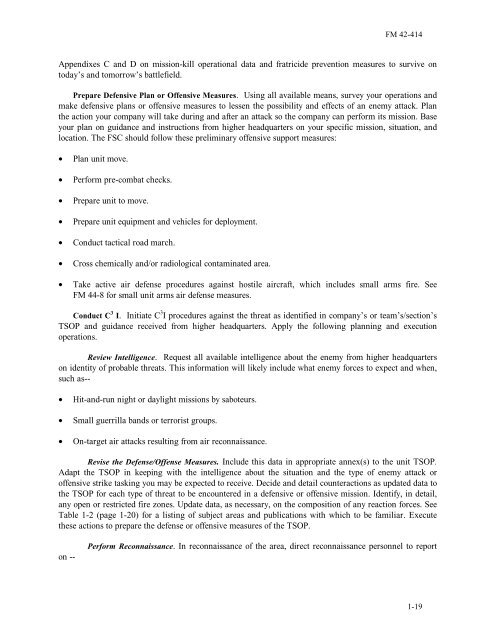Tactics, techniques, and procedures for - Army Electronic ...
Tactics, techniques, and procedures for - Army Electronic ...
Tactics, techniques, and procedures for - Army Electronic ...
Create successful ePaper yourself
Turn your PDF publications into a flip-book with our unique Google optimized e-Paper software.
FM 42-414<br />
Appendixes C <strong>and</strong> D on mission-kill operational data <strong>and</strong> fratricide prevention measures to survive on<br />
today’s <strong>and</strong> tomorrow’s battlefield.<br />
Prepare Defensive Plan or Offensive Measures. Using all available means, survey your operations <strong>and</strong><br />
make defensive plans or offensive measures to lessen the possibility <strong>and</strong> effects of an enemy attack. Plan<br />
the action your company will take during <strong>and</strong> after an attack so the company can per<strong>for</strong>m its mission. Base<br />
your plan on guidance <strong>and</strong> instructions from higher headquarters on your specific mission, situation, <strong>and</strong><br />
location. The FSC should follow these preliminary offensive support measures:<br />
• Plan unit move.<br />
• Per<strong>for</strong>m pre-combat checks.<br />
• Prepare unit to move.<br />
• Prepare unit equipment <strong>and</strong> vehicles <strong>for</strong> deployment.<br />
• Conduct tactical road march.<br />
• Cross chemically <strong>and</strong>/or radiological contaminated area.<br />
• Take active air defense <strong>procedures</strong> against hostile aircraft, which includes small arms fire. See<br />
FM 44-8 <strong>for</strong> small unit arms air defense measures.<br />
Conduct C 3 I. Initiate C 3 I <strong>procedures</strong> against the threat as identified in company’s or team’s/section’s<br />
TSOP <strong>and</strong> guidance received from higher headquarters. Apply the following planning <strong>and</strong> execution<br />
operations.<br />
Review Intelligence. Request all available intelligence about the enemy from higher headquarters<br />
on identity of probable threats. This in<strong>for</strong>mation will likely include what enemy <strong>for</strong>ces to expect <strong>and</strong> when,<br />
such as--<br />
• Hit-<strong>and</strong>-run night or daylight missions by saboteurs.<br />
• Small guerrilla b<strong>and</strong>s or terrorist groups.<br />
• On-target air attacks resulting from air reconnaissance.<br />
Revise the Defense/Offense Measures. Include this data in appropriate annex(s) to the unit TSOP.<br />
Adapt the TSOP in keeping with the intelligence about the situation <strong>and</strong> the type of enemy attack or<br />
offensive strike tasking you may be expected to receive. Decide <strong>and</strong> detail counteractions as updated data to<br />
the TSOP <strong>for</strong> each type of threat to be encountered in a defensive or offensive mission. Identify, in detail,<br />
any open or restricted fire zones. Update data, as necessary, on the composition of any reaction <strong>for</strong>ces. See<br />
Table 1-2 (page 1-20) <strong>for</strong> a listing of subject areas <strong>and</strong> publications with which to be familiar. Execute<br />
these actions to prepare the defense or offensive measures of the TSOP.<br />
on --<br />
Per<strong>for</strong>m Reconnaissance. In reconnaissance of the area, direct reconnaissance personnel to report<br />
1-19

















